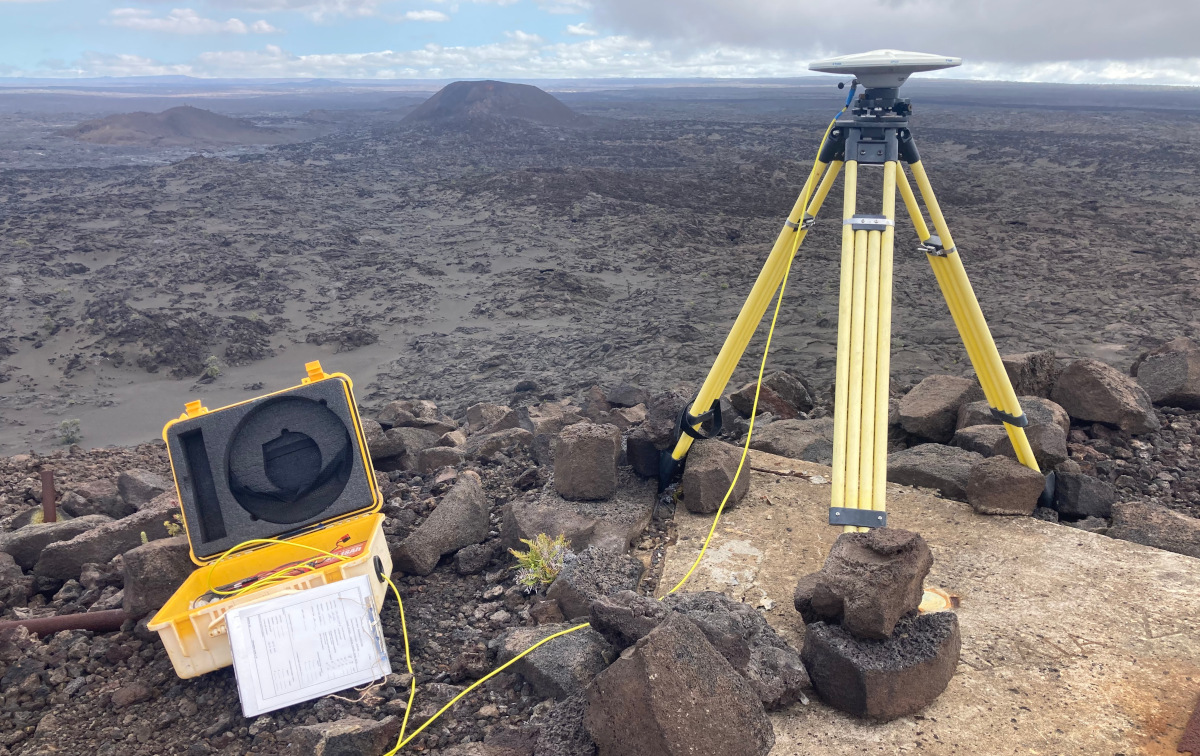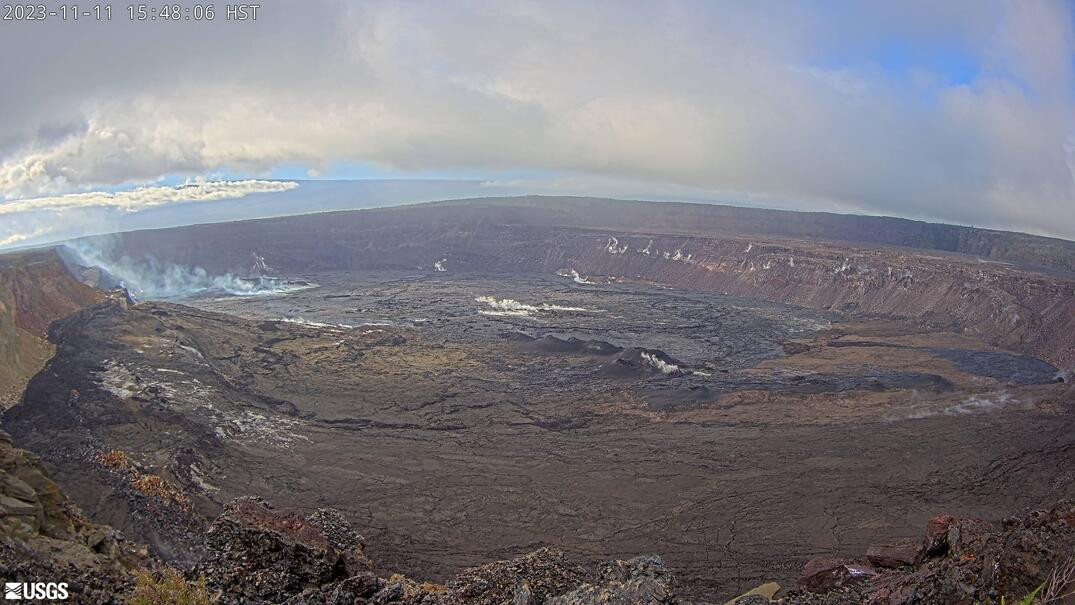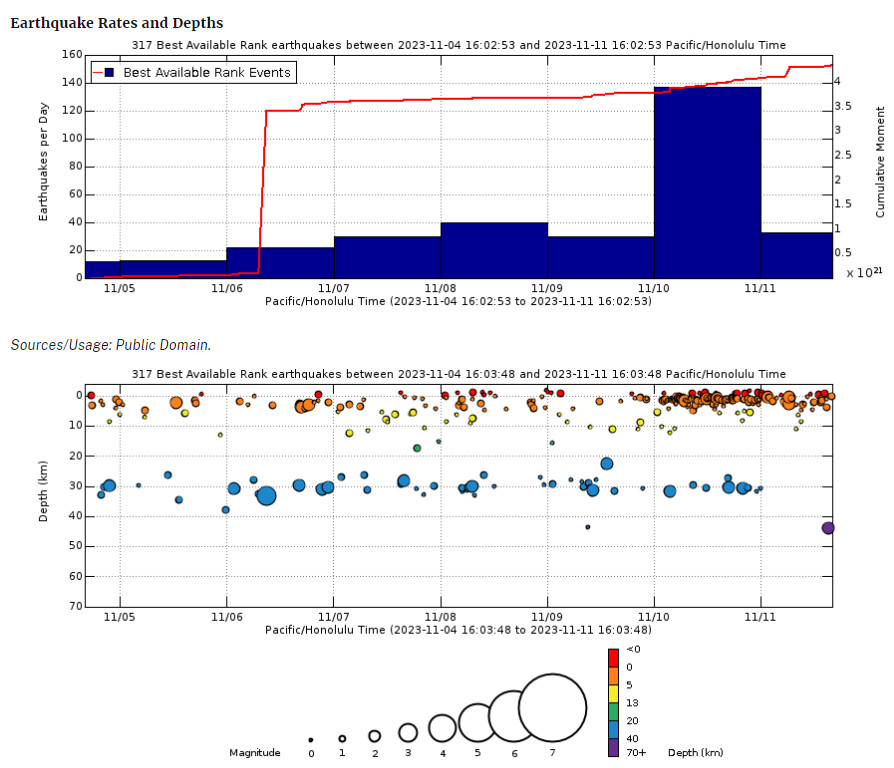
USGS: “A GPS survey benchmark is being occupied on the Southwest Rift Zone of Kīlauea. The metal disk on the ground beneath the tripod is the benchmark, which is cemented to the lava flow surface. Each year during the Kīlauea GPS campaign survey, a high-precision GPS unit is centered over the benchmark to collect data. The height of the GPS unit on the tripod is accounted for when calculating how much the benchmark has moved vertically and horizontally over the past year.” (USGS photo by A. Ellis)
(BIVN) – Kīlauea volcano is not erupting, and the minor swarm of seismicity immediately south of Kīlauea’s caldera that was observed on Friday has diminished today.
The USGS Hawaiian Volvano Observatory says it continues to monitor the activity, and on Saturday scientists reiterated that “eruptive activity could occur in the near future with little or no warning.”
The USGS Alert Level for Kīlauea remains at ADVISORY, as the unrest associated with the early October magma intrusion, measured to the southwest of the summit, has diminished over the past week. Scientists expect the signs of unrest to wax and wane with changes to the input of magma into the area.
From the Saturday update by USGS HVO:
Summit Observations: Unrest around the summit area of Kīlauea has decreased over the past 24 hours. In the previous 24 hour reporting period, an earthquake swarm occurred at Kīlauea’s summit (20 earthquakes between 5 and 7am HST yesterday). Yesterdays earthquakes were primarily located immediately south of Halemaʻumaʻu mostly within Kīlauea’s caldera. HVO continues to monitor the reduced seismic activity.
The Uēkahuna summit tiltmeter, located northwest of the caldera, continues to show slight deflation over the last 24 hours. However, the Sand Hill tiltmeter, located southwest of the caldera, continues to show an increase in uplift rates over the last 24 hours suggesting inflation of a source south of Halemaʻumaʻu. Overall, the summit of Kīlauea remains at a high level of inflation, above the level reached prior to the most recent eruption in September 2023.
Sulfur dioxide (SO2) emission rates remain low and were measured at a rate of about 100 tonnes per day on October 19, 2023.
There is currently no sign of an imminent eruption, but eruptive activity is possible in the coming weeks or months. Increased inflation and earthquake activity (heightened unrest) are expected to precede an eruption. The onsets of previous summit eruptions have been marked by strong swarms of earthquakes caused by the emplacement of a dike 1-2 hours before eruptions.
The USGS HVO scientists also provided a more detailed update on the East and Southwest Rift Zones. From the November 11th update:
Rift Zone Observations: Over the past week, a small cluster of several dozen earthquakes has occurred in the middle Southwest Rift Zone. Most events have been smaller than magnitude-2 and have located near the 1823 vents, at depths of 1-3 miles (1-5 km) below sea level. Earthquake activity in this area has ceased over the past several days, but we continue to closely monitor this area. There have been several minor episodes of seismicity in the Upper East Rift zone in the past month, but no unusual activity has been noted along the rest of the East Rift Zone. Measurements from continuous gas monitoring stations downwind of Puʻuʻōʻō in the middle East Rift Zone have been below detection limits for SO2, indicating that SO2 emissions from Puʻuʻōʻō are negligible.
The Hawaiian Volcano Observatory will continue to issue daily Kīlauea updates.



by Big Island Video News4:38 pm
on at
STORY SUMMARY
HAWAIʻI ISLAND - In recent days, there have been small episodes of seismicity immediately south of Kīlauea’s caldera, in the middle Southwest Rift Zone, and even on the Upper East Rift zone.